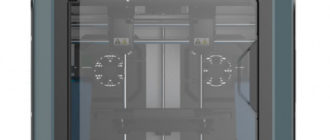Today we will talk not about standard consumables such as PLA, ABS, PETG used on Raise3D E2 3D printers (see printing examples here), but about materials for 3D printing of buildings on the Moon.
Serafim Degtyarev, a graduate of the Composite Materials, Structures and Microsystems Technologies Department at the Moscow Aviation Institute (MAI), has developed a building material based on a lunar regolith simulant and polystyrene. Such materials can be used in the construction of lunar objects with the help of additive technologies.
According to the press service of the MAI, Seraphim studied the possibilities of obtaining polymer composite materials based on lunar soil simulants of different granulometric and powder-like polymer compositions. For that purpose he has selected imitator compositions of lunar soil with different granulometric compositions, polymeric powder-like binders and studied flowability, tabletability and other technological properties at maximum permissible quantity of the imitator. The Earth analogue of the lunar regolith was basalt, which was similar in its chemical composition.
“The topic of my master’s thesis was offered at the department, and I got carried away, since Russia had just announced the plans to create its permanent base on the Moon,” Seraphim said.
The filler and the binder were pressed in a cylindrical mold at different pressures up to 130 MPa. It resulted in molded pellets with a diameter of thirty millimeters. Then the scientist investigated the density and porosity of the obtained samples, as well as the strength characteristics of the powder compositions of different compositions.
The author believes that additive technologies would be the optimal way of producing structures from such materials. The method would require melting the ground with solar heat or microwave radiation.
“With the help of 3D printing, it is possible to create construction elements from polymer composite materials based on lunar soil with polymer additives supplied from Earth. They will be a PCM matrix, and both thermoplastics and thermosets can be used as such a matrix, – explains the researcher, – In order to give the regolith the desired shape and solidity, it must first be fused or sintered. For this, we propose to use a highly filled polymer composition of regolith powder and polymer powder delivered from the Earth. As the temperature rises, the polymer powder changes to a sticky flowing state and imparts solidity to the material with relatively low energy consumption. It ensures the tightness and resistance of the material to the factors of outer space that are valid on the surface of the Moon.”
Currently, the young scientist is working on a research paper and plans to study the possibility of creating a new material with even lower binder content (with a mass fraction of up to 3-5%), as well as to consider using binders from other thermoplastics and reactoplastics.







